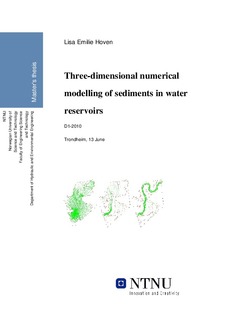| dc.contributor.author | Hoven, Lisa Emilie | nb_NO |
| dc.date.accessioned | 2014-12-19T12:31:25Z | |
| dc.date.available | 2014-12-19T12:31:25Z | |
| dc.date.created | 2011-05-26 | nb_NO |
| dc.date.issued | 2010 | nb_NO |
| dc.identifier | 419409 | nb_NO |
| dc.identifier.uri | http://hdl.handle.net/11250/242152 | |
| dc.description.abstract | Many places in the world the rivers transport a lot of sediments. When these sediments enter slow flowing areas like a water reservoir, the sediments are deposited. This leads to a reduction in the volume of the reservoir. The object of this project is to do three-dimensional numerical modelling of sediments in a water reservoir in using the SSIIM model. The chosen reservoir is the Angostura reservoir in Costa Rica. This reservoir has significant sediment problems and is flushed two times per year. Both the deposition of sediments and the flushing of the reservoir should be modelled.
SSIIM is a computational fluid dynamics program tailor-made for hydraulic engineering. The program can model sediment transport in a reservoir with a movable bed and varying water level, because of this it is suited to model both sediment deposition and reservoir flushing. An unstructured grid with about 27 000 cells is made for the Angostura reservoir. This grid is used for all the simulations and for an analysis of the volume development of the reservoir.
The Angostura reservoir was put into operation in year 2000. The yearly inflow of sediments is estimated to be 1.5 million tonnes, this sediment inflow led to a reduction in the reservoir volume. Data from bathymetric surveys has been used as input data for SSIIM, to analyse the volume development of the reservoir. After six years of operation the reservoir had lost almost 30% of its volume. At this time it was decided to do two yearly flushings instead of one as had been done up to this time. After this the volume has remained quite stable with only a slight decrease.
The Angostura reservoir is flushed in September and in November every year. Three main simulations have been carried out: simulation of sediment deposition from November until September, simulation of the September flushing, and simulation of the November flushing. After countless tests, the algorithms and parameters giving solutions as close to the measured data as possible, is found. There are still many uncertainties concerning both input data and algorithms used. Further work on the model is therefore recommended. The model successfully simulates deposition and flushing of the reservoir. With further testing and development the model can be used to predict the future volume development of the Angostura reservoir. | nb_NO |
| dc.language | eng | nb_NO |
| dc.publisher | Norges teknisk-naturvitenskapelige universitet, Fakultet for ingeniørvitenskap og teknologi, Institutt for vann- og miljøteknikk | nb_NO |
| dc.title | Three-dimensional numerical modelling of sediments in water reservoirs | nb_NO |
| dc.type | Master thesis | nb_NO |
| dc.contributor.department | Norges teknisk-naturvitenskapelige universitet, Fakultet for ingeniørvitenskap og teknologi, Institutt for vann- og miljøteknikk | nb_NO |
